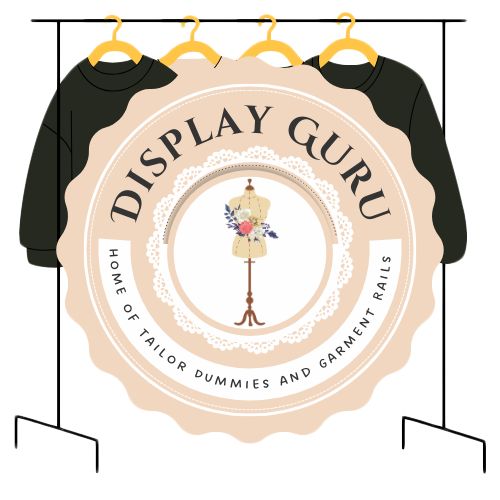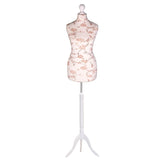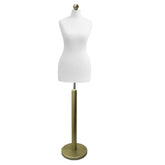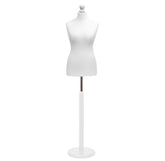Choosing Your Perfect Mannequin on Stand
A quality mannequin on stand is so much more than a glorified coat hanger. It’s your silent salesperson, a powerful tool that shapes how customers see your brand and, ultimately, helps drive sales. The stand itself—the material, the weight, the style—is a huge part of that equation.
Why Your Mannequin Stand Choice Matters

It’s best to think of a mannequin and its stand as a single package. The stand is the foundation, and getting it wrong can completely undermine the product you’re trying to show off. It’s the unsung hero of the display, providing stability, defining the mannequin’s posture, and reflecting your shop’s unique style.
This duo is a cornerstone of great visual merchandising. A cheap, wobbly base can make even the most luxurious coat look flimsy. In contrast, a solid, elegant stand instantly signals quality and a keen eye for detail before a customer even lays a hand on the fabric. Getting this right is a direct investment in your brand.
The Strategic Role of the Stand
A stand does more than just keep the figure from falling over; it plays a few crucial strategic roles. Every detail, from the finish on the metal to whether it's height-adjustable, adds up to create a display that works hard for you. A thoughtful choice makes your presentation both beautiful and practical.
Here’s what the right stand really influences:
- Garment Presentation: The stand directly affects how a garment hangs. A good base lets the clothing drape naturally, showing off the cut and flow without any awkward pulling or bunching.
- Customer Engagement: A striking display is a magnet for shoppers. The right mannequin on stand creates a visual focal point, telling a story that grabs attention and invites people to come closer.
- Brand Perception: A sleek chrome base gives off a modern, almost industrial vibe. A classic wooden tripod, on the other hand, might suggest heritage and traditional craftsmanship. The stand is a shortcut to defining your brand’s personality.
A well-chosen mannequin stand does more than prevent a display from toppling over; it anchors your entire visual narrative, silently communicating the quality and style of your collection to every person who walks by.
More Than Just Aesthetics
Of course, the practical side of things is just as important as the look. Stability is non-negotiable, especially in busy shops where accidental bumps are a daily reality. A heavy, well-made base keeps your valuable stock safe and, just as importantly, keeps your customers safe too.
On top of that, adjustability gives you options. It lets you change heights for different types of clothing or build more dynamic, layered displays that really catch the eye. Once you understand these details, you can properly explore the different display stands for clothing out there and find the perfect match for your space.
Decoding the Different Mannequin Stand Types
Choosing the right stand for your mannequin can feel like a minefield. With options ranging from hefty metal plates to elegant wooden tripods, it’s easy to get lost. But it’s simpler than it looks once you grasp the basics. The stand is the very foundation of your display, and it does more than just hold the mannequin up—it sets the tone, ensures safety, and dictates how you can present your garments.
Think of the base as the mannequin's anchor. A heavy, flat steel base gives off an industrial, rock-solid vibe, making it perfect for busy retail floors where a tip-over is not an option. On the other hand, a clear glass or acrylic base creates a minimalist, almost floating effect, ensuring all eyes are on the clothing. The material you choose sends a subtle but powerful message about your brand identity.
This decision is more crucial than ever for UK retailers. The UK mannequin market hit around USD 278.2 million in 2023 and is expected to more than double by 2030. This growth highlights a major shift towards more thoughtful and sophisticated visual merchandising across the board.
The Foundation: Materials and Shapes
When you get down to it, the two most important factors are the base's material and its shape. A square metal base, for instance, offers a sharp, modern look. A circular base often feels a bit softer and more traditional. Wooden stands, especially the classic tripod designs, evoke an artisanal, heritage quality—a perfect match for boutiques or brands built on craftsmanship.
This handy visual breaks down what you can expect from the most common materials.

As you can see, there are clear trade-offs. Steel gives you unbeatable durability for high-traffic spots. Fibreglass is a fantastic lightweight and versatile choice, while wood remains a go-to for its timeless look and cost-effectiveness.
Moving up from the base, the next piece of the puzzle is the support rod. This is the vertical pole that connects the base to the mannequin itself, and how it attaches makes a huge difference.
Choosing a stand is like choosing the right shoes for an outfit. The wrong pair can throw off the entire look, while the perfect one provides support and completes the visual story with confidence and style.
Choosing the right stand isn't just a practical decision; it's a creative one. Let's look at a quick comparison to see how different options stack up against each other.
Comparing Common Mannequin Stand Options
| Stand Type | Material | Primary Use | Stability Rating | Aesthetic Style |
|---|---|---|---|---|
| Flat Metal Base | Steel, Aluminium | High-traffic retail, heavy garments | ★★★★★ (Very High) | Modern, Industrial, Minimalist |
| Glass/Acrylic Base | Tempered Glass, Acrylic | Boutique displays, high-end fashion | ★★★☆☆ (Moderate) | Elegant, Contemporary, 'Invisible' |
| Tripod Stand | Wood, Metal | Dressmaking, studios, vintage shops | ★★★★☆ (High) | Classic, Artistic, Rustic |
| Quad Stand | Wood, Metal | Tailoring, window displays | ★★★★★ (Very High) | Traditional, Sturdy, Functional |
This table gives you a at-a-glance guide. As you can see, a flat metal base is your best bet for pure stability, whereas a glass base is all about aesthetics. The right choice truly depends on where and how you'll be using the mannequin.
Support Rods: The Unseen Hero
The support rod might seem like a minor detail, but it’s the component that dictates how the mannequin is held and what kind of clothing you can display effectively. You'll typically come across two main options:
- Calf Rod: This is the industry standard. The rod inserts into a fitting on the mannequin’s calf, providing excellent stability while leaving the feet completely free. It’s the perfect all-rounder for displaying trousers, skirts, and dresses.
- Foot Spike (or Foot Rod): This rod has a spike that fits directly into the sole of the mannequin's foot. This setup is non-negotiable if you plan on displaying shoes, hosiery, or socks, as a calf rod would get in the way.
Ultimately, your merchandising goals will steer you to the right choice. A calf rod is a versatile workhorse for general apparel, but for any footwear-focused display, the foot spike is essential. Many tailors and designers have strong preferences, and you can explore this topic further in our in-depth guide to the dress form stand.
Selecting the Right Mannequin Material and Size

Picking the right stand is only half the battle; the mannequin's body is just as vital. The material you choose will define its lifespan, finish, and price tag, while the size dictates how well it speaks to your ideal customer. Nail these two, and you’ll have a display that presents your clothing in the best possible light.
The material of your mannequin on a stand can instantly shape how a customer perceives your brand. It’s a classic case of good, better, and best, with each tier striking a different balance between durability, fine detail, and cost. It's a decision retailers are taking more seriously than ever. In fact, the UK's mannequin market recently hit a value of USD 109 million—a solid 13% jump from the previous year—showing a clear trend towards investing in high-quality visual merchandising.
Comparing Popular Mannequin Materials
Getting to grips with the pros and cons of different materials means you can invest your money wisely. The market is dominated by three main types, and each has its place depending on the retail environment and budget.
-
Plastic Mannequins (Good): Think of these as the reliable workhorses of the retail world. They're tough, budget-friendly, and hard to break, which makes them perfect for busy shop floors or temporary pop-ups. The trade-off? They often lack the realistic detail and premium feel of other options.
-
Fibreglass Mannequins (Better): A definite step up. Fibreglass can be sculpted into incredibly detailed, lifelike forms with a much more elegant finish. They’re surprisingly lightweight and versatile, but you do need to handle them with a bit more care, as they can chip or scuff over time.
-
Fabric-Covered Forms (Best for Tailoring): Typically built over a polystyrene base, these are an absolute must for designers, tailors, and dressmakers. Their pinnable surface is a game-changer for draping fabric, fitting patterns, and altering garments right on the form. For creative work, their versatility is unmatched.
Sizing for Relatability
Material aside, the size and proportions of your mannequin are crucial. This isn't just about quoting numbers on a tag; it's about making a genuine connection with your customer. A good mannequin should be an aspirational, yet believable, stand-in for your target audience.
Imagine trying to sell petite clothing on a standard UK size 12 mannequin—the fit would look all wrong. On the flip side, a plus-size brand that uses mannequins reflecting their customers' shapes will find shoppers can instantly visualise how a garment will look and feel on their own body.
A mannequin that mirrors your customer's body type does more than just display clothing—it builds an instant connection, telling the shopper, "This was made for you."
Getting the proportions just right is an art in itself. To really master this, you need to understand how to take and interpret measurements correctly. For a proper walkthrough, have a look at our complete guide on mannequin measurements. It’ll help you choose a form that not only looks professional but truly clicks with the people you’re trying to reach.
Assembling Your Mannequin for a Secure Display
An expertly styled mannequin can stop a customer in their tracks, but that only works if it’s stable and secure. A wobbly or poorly assembled display doesn't just look unprofessional; it can be a real hazard on a busy shop floor. Let's walk through how to get it right and remove the guesswork, creating a polished setup that lasts.
Your first step happens the moment you open the box. It’s always a good idea to lay out all the parts—the base, the support rod, torso, and limbs—and give them a quick once-over. This simple inventory check makes sure everything is there and in good condition, saving you a world of frustration down the line.
Once you're ready, the key is to start from the ground up.
Building Your Base
Think of the base and support rod as the foundation of your entire display. Getting this connection right is the single most important step for a stable mannequin.
- Attach the Rod: Slot the vertical support rod into its designated opening on the base. You'll almost always find a screw or bolt mechanism on the underside.
- Tighten Securely: Use the tool that came with it (usually an Allen key) or a wrench to tighten this connection until it’s completely firm. Do not skip this step. Honestly, a loose rod is the number one reason mannequins wobble.
Assembling the Body
With the stand solid and ready, it's time to put the mannequin itself together. Most forms arrive in several pieces, which makes them easier to ship and, importantly, easier to dress. The limbs usually connect with simple twist-and-lock fittings or spring-loaded pins.
I find it easiest to attach the legs to the torso first, then the arms. If you're working with a more flexible model, like an adjustable dressmaker dummy, it’s a good idea to get the limbs positioned before you mount the form onto the stand. It just gives you much better leverage and control.
A correctly assembled mannequin stands with confidence. The goal is to create a form that feels like a single, solid unit, with no rattling or loose joints.
With the body assembled, you can carefully slide the mannequin onto the support rod. Make sure the fitting, which is typically in the calf or sometimes the foot, is seated all the way down.
Balancing and Troubleshooting
You’re not quite done once everything is put together. Dressing the mannequin, especially with heavy or asymmetrical items like a big winter coat or a one-shoulder dress, can throw off its centre of gravity. Always give it a quick stability check after adding the garments.
If you run into any trouble, here are a few quick fixes from experience:
- Wobbly Base: First thing's first, double-check that the rod is tight. If it is, the culprit might be an uneven floor. A small, discreet shim placed under one side of the base will usually level it out perfectly.
- Misaligned Fittings: If a limb just won't connect smoothly, never force it. Take it apart, check that the locking mechanism is fully open, and make sure there's no stray packaging or debris inside the joint.
- Leaning Torso: This is all about balance. If you’ve styled it with heavy accessories on one side, try adding a counterweight—like a stylish handbag on the opposite arm—to even things out.
Following these practical steps will help you confidently create a secure, professional mannequin on stand that showcases your garments safely and effectively.
Styling Your Mannequin to Tell a Story

Once your mannequin is assembled and steady on its stand, the real work begins. It’s easy to see it as just a frame for clothes, but in reality, a mannequin on stand is your silent salesperson—a blank canvas waiting to tell a story that grabs customers and shows them what your brand is all about.
This is the heart of visual merchandising. Small tweaks to posture, clever layering, and the perfect accessories can instantly set a mood. A mannequin with its arms slightly raised might suggest energy and excitement, while a gentle tilt of the head can create an air of elegance or curiosity.
Crafting a Compelling Narrative
Try to think of each display as a single frame in a larger story. Does your brand speak to urban adventurers, lovers of lazy weekend comfort, or those seeking timeless evening glamour? The way you dress and pose your mannequin should give an immediate answer. Even subtle touches, like a casually slung scarf or a precisely placed handbag, can add depth to the story you’re telling.
This kind of visual storytelling is a cornerstone of the modern retail experience. It's no surprise that the global mannequin market has reached a value of USD 5.4 billion. The UK alone makes up a significant 9.31% of the European market, which is valued at around USD 1.1 billion. These numbers highlight just how much businesses rely on these figures to connect with shoppers.
To take your displays from simple product showcases to powerful visual narratives, it's worth exploring effective merchandising strategies that truly capture customer attention.
Techniques for Dynamic Displays
Getting away from single, static poses is crucial for building a world your customers want to step into. Think of yourself as a director, arranging your mannequins not just as individuals but as characters interacting with each other and the space around them.
Here are a few practical techniques to get you started:
- Create Groupings: Arrange several mannequins together to suggest a social scene. You could have one looking towards another, creating a silent conversation that draws the eye and invites the customer to join in.
- Spotlight a 'Hero' Piece: Make your must-have seasonal item—like a show-stopping coat—the centre of attention. Position it on the main mannequin and dress the surrounding figures in complementary, more subtle outfits to make the hero product pop.
- Use Props with Purpose: Props add context and personality. A mannequin holding a book creates a thoughtful, intellectual vibe, while one casually leaning on a bicycle instantly communicates an active, on-the-go lifestyle.
The goal is to do more than just make people glance at your window. A brilliantly styled mannequin doesn't just display an outfit; it sells a feeling, an aspiration, helping the shopper imagine themselves living that life.
Learning how to properly dress these forms is a fundamental skill for any visual merchandiser. For a deeper dive into the practical side of things, our guide on https://www.displayguru.co.uk/blogs/news/how-to-dress-a-mannequin is a great place to start. By putting these ideas into practice, you can turn a simple shop floor into a destination that tells a story and, most importantly, encourages customers to become part of it.
Keeping Your Mannequin Looking Its Best
Think of your mannequin on a stand as a long-term investment in your shop's visual appeal. Just like any key piece of equipment, it needs a bit of looking after to keep it in prime condition. A little regular care goes a long way, ensuring it looks sharp for years and continues to show off your products perfectly.
If you let things slide, you’ll soon notice scuffs, wobbly bases, and a generally tired appearance that can really let down the clothes you’re trying to sell. The good news? A simple and consistent routine is all you need to protect your investment.
A Quick Care Checklist
Staying on top of maintenance doesn't have to be a chore. A few consistent checks can stop small scuffs and wobbles from turning into bigger headaches down the line.
- A Gentle Clean: For plastic or fibreglass models, just wipe them down with a microfibre cloth and a mild cleaner. Steer clear of harsh chemicals, as they can easily ruin the finish. For the stand, a bit of metal polish will bring back that brand-new shine.
- Check the Fittings: Once a month, give all the connections a once-over. That means the bolts holding the rod to the base and any joints on the mannequin itself. Tighten up anything that’s worked its way loose from being dressed and moved around.
- Base Stability: Make sure the base is sitting flat and firm on the floor. A wobbly stand is not only unprofessional, it's a potential safety risk for customers and staff.
Don’t forget about storage! How you store your mannequin is just as important as how you clean it. Taking it apart and wrapping it properly is the secret to avoiding those annoying chips and scratches.
Storing Your Mannequin the Right Way
When your mannequin is off-duty, proper storage is key. The first rule is to always take it apart—torso, limbs, and stand all separated.
Wrap each piece individually. Soft cloths or bubble wrap work brilliantly to stop the parts from knocking together and causing damage. Once wrapped, pop them in a sturdy box and store them somewhere out of the way, where they won’t get bumped. This small effort ensures your mannequin on a stand is always ready for its next big moment on the shop floor.
Frequently Asked Questions
When you're working with mannequins and stands, a few practical questions always seem to pop up. Whether you're a seasoned pro or setting up your very first display, getting these details right can make all the difference. Let's tackle some of the most common queries we hear from our customers.
How Do I Stop My Mannequin From Wobbling on Its Stand?
Nothing undermines a display faster than a wobbly mannequin. It just looks unprofessional and can even be a bit of a hazard. Nine times out of ten, the culprit is simply a loose connection. Before you do anything else, check that all the screws holding the support rod to the base are properly tightened.
If that doesn't solve it, have a look at the floor itself. An uneven surface can throw everything off balance, but a few small shims tucked under the base can work wonders. For displays with heavy garments like winter coats, think about weight distribution and try to keep it balanced. If you're still facing a wobble, it might be time to upgrade to a heavier base made of steel or one with a wider footprint for a rock-solid foundation.
Can I Use a Single Mannequin on Different Types of Stands?
Generally, yes, you can swap them around. Most mannequins and stands are made with standard fittings, usually in the calf or foot, which are designed to be compatible. It's a bit like USB ports – most things just plug and play.
That said, it's always worth double-checking. Some high-end or bespoke stands have their own unique connection systems. Before you buy a new stand or mannequin separately, confirm the fitting type and the diameter of the rod. A quick check upfront saves a world of frustration later.
What Is the Best Way to Transport a Mannequin on a Stand?
The golden rule here is to always take it apart first. Trying to move a fully assembled mannequin is a recipe for disaster, as it puts a huge amount of strain on the fittings and risks snapping something.
For a smooth and damage-free move, just follow these steps:
- Dismantle: Gently detach the arms, hands, and torso, then separate the mannequin from its stand.
- Protect: Wrap each part individually in bubble wrap or soft blankets. This prevents scratches and chips while they're in transit.
- Secure: Pack everything snugly into a strong box with plenty of padding to stop the pieces from rattling around. It's best to pack the heavy base and rod separately to protect the more delicate mannequin parts.
At Display Guru, we have a huge selection of high-quality mannequins and stands for any professional display. Find the perfect fit for your business at https://www.displayguru.co.uk.








